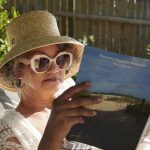Craig and I locked eyes on a Sydney street a couple of days after the 2001 Gay and Lesbian Mardi Gras. I was 23, new to Australia from Peru, and still shaking off the cobwebs of a conservative Catholic upbringing.
To me, Craig looked like someone from another planet: a lean, strong frame, curly beach-blond hair and a smile that seemed to light up the whole city. My English was basic but our shared sense of humour cut through the language barrier.
That evening, Craig dropped me home in his hippy van. He told me he worked as a graphic designer but had aspirations to be an artist. Before I got out of the van, he gave me a kiss so tender it felt like a stamp of love.
Days later I moved into Craig’s shared rental flat in Tamarama. He had an affinity with nature, and I’d often find him talking to insects as they crawled up his arm. The Pacific Ocean was on our doorstep, and he loved to body-surf way out where the surfers were. He encouraged me to push through my fear of the ocean, teaching me how to read the currents and duck under big waves.
Although an introvert himself, Craig didn’t mind me bringing streams of new acquaintances back to our apartment, and together we began to build a soul family.
Around this time, Craig decided to quit his job to pursue art full-time. As Craig worked to establish a name for himself, we subsisted on white bread with Vegemite, cheese and tomatoes.
In 2002, Craig had his first solo art show, and in 2004 he won the Archibald prize – Australia’s most prestigious portrait prize – for his charcoal drawing of Yolŋu actor David Gulpilil. That changed our lives. We were able to buy the apartment next door, and in 2008, as the financial crisis dealt a blow to art sales, we relocated for a time to South America, living in Rio de Janeiro and Buenos Aires. Despite the crisis in South America, people continued to create art, go out, gather and enjoy life.
When we returned to Sydney in 2012, our relationship was at a crossroads. Craig was craving a life closer to nature, while I, a city person, wanted to return to Buenos Aires. We discussed the possibility of long distance, but this potential separation weighed heavily on me so I agreed to accompany him on a research trip up to the northern rivers region of New South Wales.
One afternoon after we arrived, we left the coast and drove inland, through the Byron hinterland, to look at a property for sale. We got out of the van at a ridge that looked towards mountains. Craig was transfixed by the view. The yard was full of old car parts, bottles and overgrown lantana. The redbrick house was tiny, with low ceilings and walls marred by punches. But Craig was smitten and declared it was the place he wanted to live and die. I could see the challenge it presented through his artist’s eyes, so I decided, cautiously, to trust his vision.
We moved into a tent beneath an open bay shed on the property. One night, we awoke to find a large rat had chewed through the netting and was feasting inside the bread bag. I was not impressed. I confided in Craig how isolated I felt living there. Ever the optimist, he reassured me: “Don’t worry, my love. People will follow.”
One day soon after, I heard Craig yell out from inside the shed. I came running in to find two thick grey and white pythons on an overhead beam, wrapped around each other, moving side to side, writhing powerfully. “They’re fighting,” I gasped. Craig responded: “They’re making love!” We laughed. The snakes were so oblivious to us that I forgot to be scared, even when they dropped to the floor and continued tussling. Whatever the brazen pair were doing, there was something sensual, passionate and wondrous about it. As Craig and I stood there together, mesmerised, I realised with absolute certainty I wanted our lives to always be intertwined.
After that, I started to see the beauty in our rural life. We cleared the lantana and replaced it with a vegetable garden. The punch-marked house became our home and a magnet for friends and family. By day Craig painted in the converted shed, and by night we hosted gatherings around our campfire, shared meals in the kitchen and danced. The isolation I had feared melted away.
In January 2022, Craig passed away at home from Covid complications. He was 53. The loss still feels insurmountable. But Craig left me with the greatest gift – a life intertwined with nature and a community who each day helps me navigate the grief. I see him in the technicolor sunsets, in the rustling leaves and in the kookaburras whose easy laughter echoes around the bush. I believe Craig’s spirit remains in the natural world that surrounds me.
A Portrait of Love, a documentary by Molly Reynolds about Roberto and Craig’s relationship, is screening at Dendy Newtown in Sydney on 10 June, at Cinema Nova in Melbourne on 11 June, at Deckchair Cinema in Darwin on 21 June and at Byron Theatre in Byron Bay on 22 June








